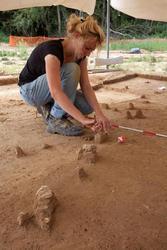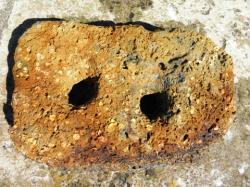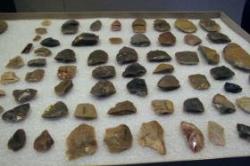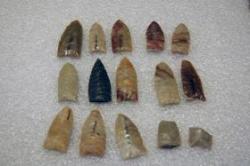- 12 SEPTEMBRE
- INDI-UNI : ANTHROPOLOGIE - ARCHEOLOGIE
INSCRIPTION 2011 – 2012 COURS A DISTANCE
REGISTRATION 2011 – 2012 ONLINE COURSES
- ALGERIE – Lambèse - Interrompues en novembre 2009, les fouilles sur le chantier vont incessamment reprendre. Une mission de 13 spécialistes du Centre national de recherche en archéologie sera de retour, à Lambèse (Tazoult), située à 12 km à l'est du chef-lieu de la wilaya de Batna. La mission serait un complément de celles menées en 2006, 2007 et 2009, lesquelles avaient pour objectif de redécouvrir les richesses archéologiques du site de Lambèse-Tazoult, parce que "Lambèse est connue de manière très incomplète, et elle a très peu fait l'objet de fouilles systématiques". Il faut savoir que les premières explorations ont eu lieu en 1848 et se sont poursuivies jusqu'au début du XXe siècle, puis plus sporadiquement jusqu'aux années 1980. Depuis, les campagnes ont cessé d'une manière totale pour reprendre en 2006, 2007 et 2009, après 26 ans de rupture. La première campagne de 2005, financée par le Service de coopération de l'Ambassade de France en Algérie et le CCF de Constantine, s'est concentrée sur l'étude des pavements conservés au musée de Lambèse et dont on a perdu les contextes archéologiques. A partir de 2006, la mission archéologique financée par la Commission des fouilles du MAE et l'ENS en 2007 , a permis d'élargir les investigations sur deux secteurs repérés en 2005 à l'emplacement d'interventions d'urgences de l'ancien conservateur A. Guerbabi en 1982 et 1994. La mise au jour de deux habitations, l'une très étendue et luxueuse située à une cinquantaine de mètres de l'amphithéâtre et probablement datable de l'époque sévérienne, l'autre plus périphérique, et probablement plus tardive, permet une approche de l'histoire du développement urbain de Lambèse. Depuis la dernière campagne en juin 2007, un panneau figuré de très grande qualité, découvert lors de la mission 2006, a été déposé par l'équipe de restaurateurs franco-algérienne, dirigée par Patrick Blanc (MAPA).
http://www.lemaghrebdz.com/lire.php?id=38350
- ROYAUME UNI – Daventry - New investigations at the site, which is located at Daventry International Railfreight Terminal (DIRFT), have given a greater insight into what happened at the 2,000-year-old community. The findings, including evidence of settlement such as hut circles, will be discussed at the Community Landscape Archaeology Survey Project (CLASP) annual meeting. CLASP project co-ordinator Dave Hayward said: “The archaeological investigations at the site carried out for these later phases, together with the work done by Northamptonshire Archaeology for the original phase, have revealed significant previously unknown archaeological features. “These finds, which have been described overall as of regional, if not national importance, have provided an insight into a large Iron Age community that was sited on lower ground at the possible interface between three tribes.” The Iron Age in Europe took place between 1200 BC and 400 AD. The early period of the age is characterised by the widespread use of iron and steel. The adoption of such material coincided with other changes in society including differing agricultural practices.
http://www.daventryexpress.co.uk/news/local/iron_age_findings_help_build_picture_1_3042211
- FRANCE –  Auneau - Pour Hervé Sellès, chef du service de l’archéologie du Conseil général, la dernière étape des interventions archéologiques préventives, prescrites par l’État dans le cadre de la déviation d’Auneau, progresse convenablement et les délais seront tenus. "La découverte de colorants rouge, de broyons et de meules à pigments datant du Paléolithique supérieur est l’une des plus remarquables", indique Marie Soressi, ingénieur de recherche à l’Inrap et responsable scientifique du chantier. "Sur plusieurs milliers de mètres carrés nous avons retrouvé les vestiges d’installations humaines préhistoriques datées du Paléolithique et du Mésolithique. Nous étudions la distribution spatiale de quelques milliers de silex taillés, de pierres chauffées et de petits fragments d’hématite, ce pigment rouge, pour retracer l'organisation des activités et les modes de vie des ces chasseurs-cueilleurs préhistoriques." L’importance des surfaces concernées feront du site d’Auneau une référence pour ces périodes dans notre région. Les vestiges du Mésolithique déjà identifiés aux abords immédiats de la rivière l’Aulnay ont été préservés et ouvriront la possibilité de recherches ultérieures.
Auneau - Pour Hervé Sellès, chef du service de l’archéologie du Conseil général, la dernière étape des interventions archéologiques préventives, prescrites par l’État dans le cadre de la déviation d’Auneau, progresse convenablement et les délais seront tenus. "La découverte de colorants rouge, de broyons et de meules à pigments datant du Paléolithique supérieur est l’une des plus remarquables", indique Marie Soressi, ingénieur de recherche à l’Inrap et responsable scientifique du chantier. "Sur plusieurs milliers de mètres carrés nous avons retrouvé les vestiges d’installations humaines préhistoriques datées du Paléolithique et du Mésolithique. Nous étudions la distribution spatiale de quelques milliers de silex taillés, de pierres chauffées et de petits fragments d’hématite, ce pigment rouge, pour retracer l'organisation des activités et les modes de vie des ces chasseurs-cueilleurs préhistoriques." L’importance des surfaces concernées feront du site d’Auneau une référence pour ces périodes dans notre région. Les vestiges du Mésolithique déjà identifiés aux abords immédiats de la rivière l’Aulnay ont été préservés et ouvriront la possibilité de recherches ultérieures.
http://www.cg28.fr/accueil-actualites/zone-en-bref/a-lire-aussi/deviation-d-auneau-les-fouilles-archeologiques-progressent
- BULGARIE –  Sozopol - Massive ancient stone anchors were found by divers participating in an archaeological expedition near the southern Bulgarian Black Sea town of Sozopol. The 200-kg beautifully ornamented anchors have two holes in them – one for the anchor rope and another one for a wooden stick. They were used for 150-200-ton ships that transported mainly wheat, but also dried and salted fish, skins, timber and metals from what now is Bulgaria's coast. The anchors' shape suggests they were used by Creto-Mycanaean, Phoenician or Carian sailors in the 15th-12th centuries BC, which would refute the hypothesis that Greeks were the first Black Sea sailors starting the 12th century BC The anchors are also said to show that the Trojan war may have started because of excise duties imposed by the Trojans, who took advantage of their control over the Dardanelles – and not because of Helen of Troj.
Sozopol - Massive ancient stone anchors were found by divers participating in an archaeological expedition near the southern Bulgarian Black Sea town of Sozopol. The 200-kg beautifully ornamented anchors have two holes in them – one for the anchor rope and another one for a wooden stick. They were used for 150-200-ton ships that transported mainly wheat, but also dried and salted fish, skins, timber and metals from what now is Bulgaria's coast. The anchors' shape suggests they were used by Creto-Mycanaean, Phoenician or Carian sailors in the 15th-12th centuries BC, which would refute the hypothesis that Greeks were the first Black Sea sailors starting the 12th century BC The anchors are also said to show that the Trojan war may have started because of excise duties imposed by the Trojans, who took advantage of their control over the Dardanelles – and not because of Helen of Troj.
http://www.novinite.com/view_news.php?id=132005
- USA – 
 West Lubbock County - In this area’s ancient history, a hard rock could determine where the next meal was coming from. A cache of projectile points and the blank rocks from which more could be made, was found in West Lubbock County about 20 years ago, and now the contents are stored in the Museum of Texas Tech. According to Eileen Johnson, executive director of the museum, the type of rocks that were used to make the points is not ordinarily found in the Lubbock area. Archaeologists suspect they may have been carried into this area, then hidden until needed later. The archaeological find was named Ryan Site for Lupton’s son, who helped uncover the artifacts during three summers of digging. Johnson estimates the age of the points and blanks at 10,000 years. She said, “Good stone material is very hard to find in this area.” The rocks from which the points were made apparently came from Central Texas or from the Amarillo area where the Alibates Quarry is located. The stone weapons were made by a culture known as Plainview, named for the city of Plainview where the particular style was first discovered in 1945. “The Plainview culture, we now know, dates to about 10,000 years ago. At that time, the maritime climate was changing to the more continental climate that we see today,” Johnson said. “So, it still would have been fairly lush grasslands. But all of the exotic fauna that we think about — mammoths, camels, bears — they’re all extinct. The big animals that made it through that extinction filter are the ancient bison,” she said. “The Plainview peoples that we call a culture, were hunting now-extinct bison with these points. And this is the only known Plainview cache — the only one. It is significant for that, but it also is very significant because it provides us the technological information on how they went about making these points,” Johnson said. Core samples of the spot where the rocks were found indicate an ancient playa lake was there. It is gone now, and all the points and blanks that could be found have been removed, too. The land is now a plowed field.
West Lubbock County - In this area’s ancient history, a hard rock could determine where the next meal was coming from. A cache of projectile points and the blank rocks from which more could be made, was found in West Lubbock County about 20 years ago, and now the contents are stored in the Museum of Texas Tech. According to Eileen Johnson, executive director of the museum, the type of rocks that were used to make the points is not ordinarily found in the Lubbock area. Archaeologists suspect they may have been carried into this area, then hidden until needed later. The archaeological find was named Ryan Site for Lupton’s son, who helped uncover the artifacts during three summers of digging. Johnson estimates the age of the points and blanks at 10,000 years. She said, “Good stone material is very hard to find in this area.” The rocks from which the points were made apparently came from Central Texas or from the Amarillo area where the Alibates Quarry is located. The stone weapons were made by a culture known as Plainview, named for the city of Plainview where the particular style was first discovered in 1945. “The Plainview culture, we now know, dates to about 10,000 years ago. At that time, the maritime climate was changing to the more continental climate that we see today,” Johnson said. “So, it still would have been fairly lush grasslands. But all of the exotic fauna that we think about — mammoths, camels, bears — they’re all extinct. The big animals that made it through that extinction filter are the ancient bison,” she said. “The Plainview peoples that we call a culture, were hunting now-extinct bison with these points. And this is the only known Plainview cache — the only one. It is significant for that, but it also is very significant because it provides us the technological information on how they went about making these points,” Johnson said. Core samples of the spot where the rocks were found indicate an ancient playa lake was there. It is gone now, and all the points and blanks that could be found have been removed, too. The land is now a plowed field.
http://lubbockonline.com/life-columnists/2011-09-11/cache-projectile-points-reflects-areas-distant-past